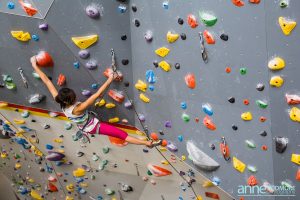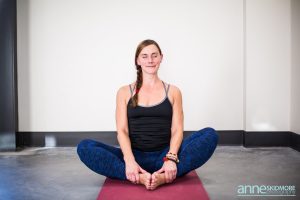From the Training Pagoda: 4 Stretches That Will Improve Your Climbing Now
Everyone knows that flexibility is critical to climbing performance, yet it’s still overlooked by many climbers. Moreover, the root cause of many climbing injuries are overworked, excessively tight muscle groups. Two of the most beneficial areas to target are the shoulders and hips. Here are a couple of basic stretches you can do while resting between climbs that will improve your performance, and help you stay injury free too.
Shoulders:

Many climbers suffer from shoulder-related issues. At best, the sheer amount of pulling climbing demands will always leave climbers susceptible to tight shoulders, poor posture, and muscle imbalances due to overly developed back muscles. At worst, many climbers suffer from chronic and painful shoulder injuries.
Downward-Facing Dog
A yoga staple, Downward Dog is an excellent full body stretch that’s particularly beneficial for shoulder mobility. Start on your hands and knees, with the hands positioned slightly more than shoulder-width apart. Lift your buttocks and slowly straighten your legs, without locking your knees and press your heels towards the ground. Engage the abdominal muscles to draw your chest towards your thighs and lift your pelvis. As you hold this position, relax your neck and head but keep the shoulders engaged. Imagine a straight line from your palms to your buttocks, and another from your buttocks to your heels.
Wall Angels
This stretch seems easy until you try it! Start by leaning your upper back, neck and head against a wall with your feet placed shoulder width apart about a foot away from the wall. WIth your elbows bent 90 degrees and hands pointing towards the ceiling, place both arms against the wall as well. Now slowly press your back straight against the wall, too. The intensity can be increased by slowly straightening the arms towards the ceiling.
 Hips:
Hips:
Hip mobility is an underappreciated weakness in many climbers’ game. Think of it this way: without any lateral hip flexibility, you would have to bend your knee directly towards the wall to step up on a foothold, forcing your hips and center of gravity away from the wall, and requiring more upper body strength to hang on and complete the move. The more you can rotate your knee to the side instead, the more your hips and center of gravity can remain directly under your hands, requiring less upper-body strength. By simply increasing your hip mobility, you can significantly reduce the amount of upper body strength a given climb requires.
Frog Stretch
There are many variations to this stretch, which is best done on a mat or padded surface to limit the stress on your knees. Starting on your hands and knees, slowly walk or slide your knees apart to open your hips. Once you have reached a comfortable distance, sink your hips back towards your feet to increase the pressure. You may drop to your elbows to further increase intensity.

Butterfly Stretch
From a seated position, bend your knees and draw your feet in towards each other so that the soles are pressed together. Allow your knees to drop to the sides as far as they will comfortably go. Pull your abdominals gently inward and lean forwards from the hips. You may grasp your feet with your hands and gently pull yourself forwards to increase the intensity. Remember to keep your back straight.
